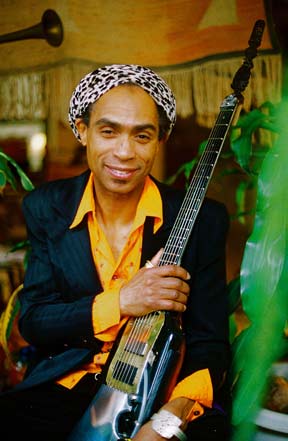
INTERVIEW: About the Release of "Djuke Music" "On Interviews On" The following interview took place in New York during the first weeks of On's new release, "X-Ray Search Light Project: Djuke Music. (December, 2002) Q: Well, On, I found this release to be quite a scope of your creative expressions. Tell us something about how it all came about. On: The session was put together as a sort of session-interaction. I presented musical designs, and then we went for it. After I heard what we got on tape, I decided to go into more depth putting more musical material behind it. What resulted was a project that lasted for months. Q: You called the compositions on the cd 'exhibitions'? On: Yes. The music is probably best realized as an exhibition. Q: We certainly hear an array of abstract musical directions, yet there is a constant level of infused dialects of blues, free jazz and Afro-rock. You also contribute some very sensual tone 'poems'. On: That's nice to hear. Well, I wanted to highlight my skills on the nylon-string acoustic (guitar). I was trained as a concertise in Vienna when I was 19, 20 years old. I had already been playing the guitar since I became interested in it at around 11. Since I was 13, I studied at the Cleveland Music School Settlement, one year at Cleveland State University's music program, and then I left for Austria. Q: I hear some Flamenco-type vibes in your classical guitar approach. The dialogues between yourself and trumpeter Electric Meg on "Veve" and "Memories of a Moving Star" brought to mind what could be alternative "sketches" of Spain.
Q: So, from a background of music training, how did you cross the lines into other music? On: I grew up in Cleveland during the Motown era. ….a really amazing time. In those days, the stars competed for hit singles, and there were hits out every week! I grew up to all the funky music imaginable. I played in a Motown-styled band in High school, steps and all… and in a Pink Floyd kind of thing, too. I was aware of Jimi (Hendrix) and (Miles Davis') Bitches Brew. I didn't really get into mainstream jazz until I was out of High school. Dizz, Bird and early Miles were new discoveries for me after I was in Europe. And, of course, while discovering Bird and all of them, the portal flew open and there was this other world….I could recognize the clarity while in Europe better. I remember being so impressed by that. The history of the music seemed to be presented with so much more clarity. I learned about people I never heard of more easily and of certain books. Q: What were some of those titles and who were some of the persons you discovered? On: Well, I remember a particular book called Free Jazz Black Power! by Carles and Cromolli. There was Albert Ayler, Trane, Sun Ra, Shepp, Don Cherry….I had to go right away to the record stores and check them out. And there they were! The cats that I had just read something about. The stores had all the records! I never even saw these titles in the stores back home. And there was all of this other kind of enthusiasm for the music over there. My dedication began to change…. Q: So what happened? On: I filled up with what I could. Two years later, I was in New York. Q: So, you packed the concert guitar away and picked up the electric (guitar)? On: Well, that was true for a long time. It was years later that I seriously went back to working on the concert repertoire. In fact, a guitar recital cd will be released from me in some near months ahead. But I did get back into the electric. I took my licks on the bandstand at different sessions around New York. New York let me be around so many of the great artists. Q: You mentioned some well-known names in your cd booklet as 'acknowledgements'. How are you connected to any of them? On: At one time or another, I was playing with them on the bandstand. All of them gave up of themselves something to me. It was important to me that I put out the recognition. Q: Is that to presume you worked with, say, Fela Kuti or Lester Bowie? On: Interesting that you should mention those two particularly. I knew Fela. Man! The mutha f*ker! Well, sorry, but that's what he liked to be tagged with. I would catch up with him every chance I got when he played in New York. I tried to spend as much time with him as I could....in the wings of the stage, backstage, at the motels. He was truly the greatest musician with the greatest political vision in all Africa. He was a tremendous inspiration for me. In all of those experiences around him, I can't believe that I never snapped a single picture together with him. But some exist somewhere because other persons did. In fact, now that I think about it, I was never in the habit of taking pictures with anyone of those that I mentioned on the cd card. And, of course, Lester recorded with Fela. Q: How were you connected to Lester? On: As far as my involvement with Lester is concerned, we never worked together. Lester crashed out on my floor a few times when he would be downtown (East Village, NYC) after late nights hanging out with drummer great Philip Wilson, who used to live across the street from me…the other mentions I actually did work with, if even just one time. Q: Like who? On: I hit with Buhaina (Art Blakey) just once at the Village Gate. The only gig I did with him, and it was there. My 90 minute 'Messengers' tour….but of all of the other artists that I listed, my musical experiences with them spanned over years. Q: What other kinds of musical situations did you get involved with? On: The usual hustle gigs….the off-Broadway, lounge gigs, club dates. I gravitated to the free-funk scene and started working with Charles 'Bobo' Shaw in the Human Arts Ensemble. That's where my association began with L.T. (Luther Thomas). I came through the Sun Ra Arkestra. I played the gigs recorded at the Squat Theatre on 23rd Street. 'Dance of Innocence' is one of them. There should be another one, too. Around that time, I also recorded and toured with Don Ayler's Septet. Q: That's Albert's brother? On: Yes. Q: That was when? On: That was already in '81 or so.
Q: Copenhagen. Isn't that where L.T. is living now? On: Yes. He's been there about six years or so, by now. Q: Tell us something about your relationship with Sun Ra. On: It seems a little funny, but I was around the band for about two years before I asked Sun Ra if I could join the Arkestra. I had learned a lot about Sun Ra from books and recordings and all….but when I first came around, I hesitated to move to Philly (Philadelphia) to live with the band because everybody in the band was always broke. Sun Ra told me one day, "You have to be a star to play in my band." But Sun Ra didn't like to pay the cats…he just wanted to take care of them from his purse, and force the cats to constantly rely on him for everything. I couldn't deal with that. But the music! So I did end up making that move for a little while. The trade off was beyond understanding…the experiences ..the whole thing. I learned to realize exactly what Sun Ra was talking about. We all did. That's why the cats stayed around. I spent a lot of time talking with him about space, of course, and all sorts of curious things…religion…his myth science thing. I discussed Buddhism very often with him. I remember after he had his second stroke and he was conducting the band telepathically. That was astonishing to see. That night backstage, June (Tyson) and myself sat with Sun Ra in total silence. Sun Ra took my hand and held it for like, 10 minutes. That was my most high moment with the visitant. ….the day Sun Ra left the planet was so calm and beautiful. The sky was illuminated. Q: You also mentioned other members of the Arkestra. Tell us something about your relationship with them. On: There was a benefit gig that lasted over an entire weekend that was put on at the Village Gate with WKCR radio for Sun Ra while he was recovering from his first stroke….Sun Ra hated the idea. It was an amazing weekend of music. All the stars came out. On one of the evenings, the Arkestra played in free-jazz mode for one solid hour…man, the sound!
I was a part of that along with Sabir Mateen and an amazing futuro-vocalist with a five octave range named Nizomi. Sun Ra hated funerals and the church services around all of that, but when Khusen left the planet, Sun Ra agreed to be a part of the memorial that we put together for him at the University of the Streets. He had never agreed to anything like that before. Q: What about John Gilmore? On: John was very compassionate. He was always so humble and respectful to everyone. It's well known that Coltrane also had a lot of respect for John. I wouldn't be surprised if I found out that Trane collected a lot of his spiritualized impressions from John. John actually left this planet twice before the final trip. Sun Ra kept him here. One time John was in a hospital bed exhausted and he left. Sun Ra told him to get back into his body, and he did. Q: Are there any recordings from the Esoteric Art Ensemble? On: There are some cassette tapes around. A good lab could probably save them. Sabir recently told me that he found one and may try to produce a release. Q: Have you done any other work with Sabir Mateen? On: There was a great group called 'The Future' that hit around 90, 91. That group included Sabir, Daniel Carter, Thom Corn, Dan O'Brien and spoken word artist Eve Packer. There are proper recordings of some gigs and we also did a studio recording. I would really like to see something released from that project. We'll see what can happen….I'm working on that now, as a matter of fact. Q: So it's been some time that passed before you made the move to put out this cd.You certainly have demonstrated the spectrum of your musical palette. What is this name for your music style, 'Africoid Design' music….this 'Djuke Music'? On: I had come up with the name 'Djuke' (pronounced (d)'joo-kie), which is related to the southern term, as in "juke" joint, which can be recognized as coming from the Seneglese Woloff language, meaning to 'get up' or to 'pull up'. It's really a caption for what some of us have been doing all along, you know, the abstracted jazzes. My focus is to further characterize the music that will describe what I call Africoid design. Q: So the roots of the 'Djuke' style is what you are calling 'Africoid' designs? On: Yes. I've given an identifiable tag-name to the music, for better or worse. I'm sure that in the Universal scheme of things, the eternal question is, 'what's in a name?'……that music is universal….is all well, but…I've chosen to put up a flag, so to speak. I feel that artists should name their own approaches, if they are able. Otherwise, new attempts at designs in art are always somehow mis-directed or categorized by critical descriptions by the imaginations of others, only because the artists themselves can't describe their own thing….or don't want to. I wanted to avoid any confused reference to my thing. It's accepting the wrong associations…. that kind of attitude destroys the possibilities for us to recognize and to accept innovation of any kind. Critics have gotten use to putting out a vibe for folks to look for the next great 'so and so'….or for putting that kind of vibe over 'other' artists, if you know what I mean. That's actually a kind of attempt to shackle creative powers. Actually, now that I think about it, why is that kind of pressure seemingly created? Who we should be looking for are definitive artists who have their finger on the pulse of the present reality. That's what the great innovators all had in common. But I do realize that the shadows casts by those giants is super difficult to come from under. The greatest real problem for any contemporary artist is to work decisively off of the earlier models. Q: Would you consider yourself to be a revolutionary? On: Well, maybe an 'opener'. Q: Your electric guitar playing on this album maintains more of an organic feeling….more 'straight', if you will, without heavy combinations of processors, yet you can get a very suspended kind of sonority when you play fast. How do you do this? On: I used very few effects at the original session. For the overdubs, I made sure that there would be no confusion between the original guitar part and the added ones, so I kept the differences of the tones apart. I applied simple effects like compression, overdrive, some distortion and a wah pedal. The rest of the sound was directly from my hands and the attack on the instrument. Q: The music is very heavily layered on some 'exhibitions'. Is heavy layering a part of the Djuke style? On: I'm still defining the Djuke thing. What I do want, however, is to get a large ensemble sound with a lot of crossing rhythms. I found that the rhythmic layers are best expressed by using sometimes up to three guitar parts. It's what I did by tracking the cuts. Q: Well, it's clear that you are getting at the 'big band' kind of thing. Now I can better connect the dots from the influences that you have already talked about. On: Yeah, that's a part of the idea. When I heard Fela perform his piece 'Music Against Second Slavery' (M.A.S.S.), it was an obvious thing of him mixing his Afrobeat with Sun Ra's abstract orchestrations. See, Fela loved Sun Ra, too. In fact, he referred to Sun Ra as being his 'grandfather'. I think that single piece from Fela united the whole world of Pan-African music. Q: Luther Thomas is always amazing to hear. How does his playing style fit into your designs? On: L.T. was there from the beginning with the Djuke vibe. He heard the name first. And besides, L.T. is family, you know? All of this is just the extensions of what we've been doing all along. Q: Is that to say that Luther Thomas has an influence in the 'Djuke Music' style? On: Well, on this
cd, no more influence than any of the other players. To some degree,
all of the players shape the music as musical language. But the designs…
that's me. On: Well, I going to start putting out word and chant.
Q: What happens to the sense of melody? On: It just gets more intriguing. Voices will always be there. Q: Bassist Atom Feller certainly creates a voice-like ambiance. I hear a lot of that type of conceptual playing from the percussionist, Tom Augsburger and ESP man Greg Lewis. Is that also 'Djuke' style, and what is ESP? On: ESP means extra-sensory percussion. Kind of a way of representing tongues of the ghosted personality.
|
Website production by Meg Montgomery for worldlyvibe.com ©2009 On Ka'a Davis All Rights Reserved.
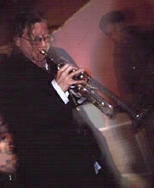

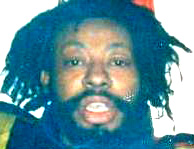
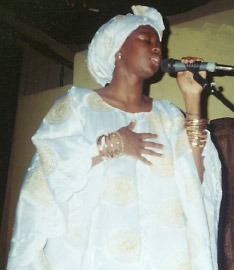 Kadiato
Sibbi
Kadiato
Sibbi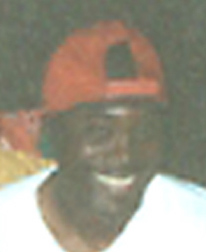 Greg
Lewis
Greg
Lewis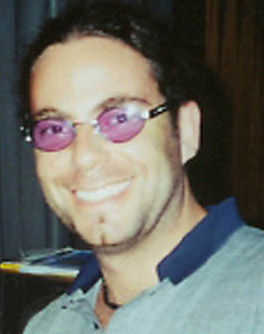 "Atom"
Feller
"Atom"
Feller